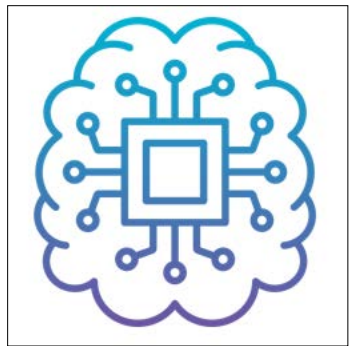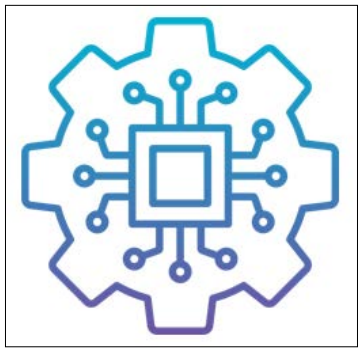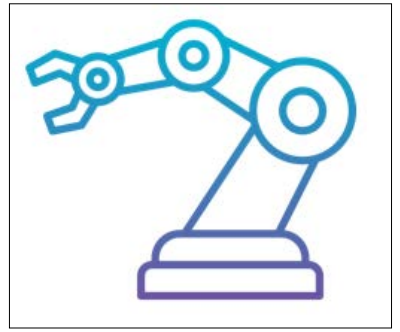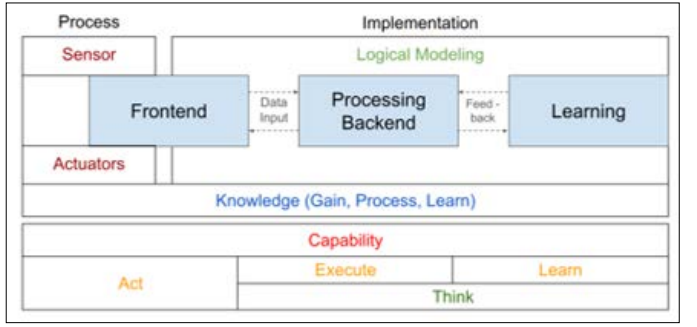Author(s): <p>Rajat Jayantilal Rathod, Himanshu K Patel and Priyank Jayantilal Rathod*</p>
Artificial intelligence and machine learning algorithms and methods are the forthcoming instances in developing advanced nuclear reactor technology, mainly micro-nuclear reactor development. This research aims to extrapolate from the existing development in this technology for constructing a concise framework for micro-nuclear reactor development. This paper describes artificial intelligence and machine learning techniques and maps their application in the forthcoming developments. All these aspects and learnings can not be bound in a single article, this research aims to address the research trajectory to propose unexplored biased or unbiased combinations of these algorithms and aspects for the micro nuclear reactor development. This research will also be helpful for the Small modular reactors and nuclear waste disposal systems development.
Artificial Intelligence (AI) is a prime technique that replicates human-like learning, adapting, and processing; using data sets through the systems and their integrations with machines. Among various artificial intelligence subsets, machine learning (ML) and deep learning (DL) are widely known subsets for human-like learning and adapting things. Recent technological developments include the usage of artificial intelligence and machine learning in various sectors like engineering, medicine, education, finance, marketing, and many more sub-applications. Many industries are adding artificial intelligence and machine learning systems with their technological solutions in routine operations [1]. Among many other AI-based technologies, ML is expanding at the rocket-speed. Machine learning is defined as a part of AI that uses computer- based algorithms that automatically modify and improve system functioning for precise results [2]. Robotic Systems with AI and ML will have a key aspect to Manufacture Advance Nuclear Reactor technology specifically Nuclear Micro Reactors as it can be manufactured in the Factory. It is essential to use robotics to manufacture Micro Reactor for the precise and reliable operations. Learning from the current robotic system for manufacturing power plants are considered and AI and ML algorithms are developed to manufacture Nuclear Micro Reactor with Robotic systems.

Figure 1: General Application Terminology
Figure 1 shows the general Artificial Intelligence and Machine Learning terminology of robotic system-based applications in Micro Reactor development.
Artificial intelligence is the root of the various disciplines that engage computer algorithms with decision-making capacity. In other words machines with a human-like brain with cognitive functionality. Figure 2 is a representation of an Artificial intelligence integrated system that thinks, acts, performs, and operates like humans. There are several algorithms and frameworks for artificial intelligence-based systems [3,4].

Figure 2: Artificial Intelligence
Machine learning is a subset of artificial intelligence. It can execute given tasks based on operation patterns without instructions. Figure 3 shows a machine learning system that has behavior recognition and data sets to be utilized for efficient task operations [4,5].

Figure 3: Machine Learning
Further, AI and ML systems-based development will require additional cyber security and safety to operate nuclear reactor systems to maintain international nuclear safety standards.
Robotic Systems
Certainly Artificial Intelligence and Machine Learning systems have several benefits but also have a few challenges. The most significant challenge is data. AI and ML-based systems require high-quality data sets to train the systems to make a healthy logical algorithm for precise nuclear reactor manufacturing operations. Data collection and labeling will be the most expensive and time- consuming process to develop an unbiased logical algorithm for the model. Robotic systems are integrated with many sensors and actuators which is a bit challenging as it will use a variety of data sets, obstacles, and uncertain environments. Additionally, robotic Artificial Intelligence and Machine Learning are the key technologies for advanced robotic systems. An autonomous robotic system will require a human-like mind and understanding to perform task-based operations without any instructions [3]. Both systems use an algorithm that will help identify the surroundings and judge the critical parameters to perform the identification and planning. AI and ML systems have the potential for wide and complex task performance for intelligent and autonomous operations [4].
Advanced Robotic systems will be a growing field that has wide applications to shape future of the robotic systems. AI and ML- based robotic systems play a major role in learning from data and solving traditional issues like object detection, object recognition, Gesture recognition, speech recognition, Service, Maintenance, Manufacturing, Medical, Military, Agriculture, and other robotic applications. Figure 4. Shows a generic 3 Degree of Freedom robotic arm that is widely used in various industries [4].

Figure 4: Robotic Arm - 3 Degrees of Freedom
Nuclear Power plants are divided into three categories that are Large-scale Scale, Small modular, and Micro reactors. Small Modular and Micro Reactors are the advanced generations of nuclear power plants. Among these two, Micro Reactors are of a small-size factory manufacturable reactor technology for power generation up to 25 MW [5].
The other two power plant types which are Small modular and Large-scale nuclear reactor technology also require AI and ML system-based components manufacturing. As a part of the standard manufacturing practice application of autonomous robotic systems with Artificial Intelligence and Machine Learning will be in demand to manufacture reactor core components and Micro Reactors [6].
system-based applications require real-time monitoring, data collection, and processing that may require high computational power and a system for precise operations. In addition to this large data sets are required to build and predict the real-time AI and ML-based systems. There will be energy and computing power constraints in the case of robotic systems-based applications.
Many AI and ML-based systems require additional robotic systems for dynamic operations in challenging environments. AI and ML System models will be designed to adapt and learn from such dynamic scenarios to operate safely and efficiently in a wide range of environments. More Autonomous systems and human interaction have critical challenges to ensure their safety to prevent accidents and detect potential hazards with other unidentified objects. AI and ML systems must be trained enough to handle such unpredictable work scenarios. In addition to the precise AI and ML model, the sensor, actuators, and other hardware essentials for accurate and reliable data processing [7].
Nuclear industries have unique challenges in developing Al and ML Systems for Micro Reactor development compared to other Industrial developments. Currently, there are only a few Micro Reactor designs and concepts that are available and can be developed using AI and ML-based robotic systems. It is indeed a critical requirement to use AI and ML-based robotic systems to manufacture Micro Reactors to optimize cost [8]. A few key challenges identified for the development are as follows:
Apart from the engineering aspects, there are potential concerns for the societal and military challenges for certain operations of surveillance and other similar applications that lead to unemployment. The limited availability of technical experts who understand the complexity of AI and ML-based Systems and Processes
Overall, AI, and ML have wide opportunities for development and significant challenges that need to be addressed, and safe, ethical, and robust frameworks and algorithms before the potential use of AI and ML-based systems [7].
AI and ML in Robotic systems have a broad scope of development. Figure 5 shows the conceptual framework of the application. The AI and ML-based robotic systems can be used for the Micro Reactor development.

Figure 5: Conceptual Framework of Application
Traditional Robotic systems have multiple sensors and actuators which are integrated with the mechanical structure of the robotic system and control system. The preliminary AI and ML based system will require precise sensing systems that can work in dynamic environments and a rigid system that can sustain dynamic environments and is capable of doing repeatable and reliable operations [8,9].
A Robotic Arm will have multiple Linear and rotary links together through joints. To make a robotic system autonomous, the system has high torque servo motors that have multiple joints and capability for linear and rotary operations. The system has a rigid structure that can withstand heavy loads in dynamic conditions. It is also capable of doing precise, reliable, safe, and efficient operations. A Robotic structure will have a certain configuration that brings a bit of limitation like grabbing and holding while integrating AI and ML Systems [10].
The primary aim of a robotic system control is the ability to transfer and complete certain tasks. Developing a control system that has multiple joints uses dynamic and inverse kinematic calculations for accurate force and movement. After solving the kinetics problem of a robotic system, it is possible to set and meet desired positions with the help of various joint angle values and settings in the robotic system. However, solving kinematic problems can be challenging for complex robotic systems that can be addressed by Machine Learning for robotic system control [10].
There are several stages of Micro-Reactor development that use AI and ML technologies for Micro-Reactor development, including design, construction, operation, and maintenance. There are specific examples of AI and ML algorithms and optimization for reactor design, predictive maintenance, and safety monitoring in nuclear engineering applications. Potential use of the robotic system for the Mirco Reactor development and operations are not limited to Reactor design, operations, fault identification, maintenance, real-time monitoring, and control but consist of safety, risk-assessment optimization, and analysis. However, recent research only proposed the application of AI and ML in Micro Reactor development using Robotic systems [10,11].
Future research outlines making an autonomous system with artificial intelligence and machine learning that provides broad solutions for nuclear component and reactor development. Simulation and Analysis of an Autonomous Robotic control System with Artificial intelligence and Machine Learning will be the preliminary objective to develop a Micro Reactor. The second phase will be to develop Physics modeling and calculations of the work for precise and reliable operations with safety and security. It will be the ideal step in manufacturing a Micro Reactor and Nuclear Power plant components. This system will require further development in cyber security to protect the whole nuclear power plant system from outer cyber attacks. Similarly, unforeseen circumstances development will also be considered for the new development and integration in the Micro Reactor technology. The Third Phase will be the experimental phase which demonstrates the suggested AI and ML-based Robotic systems for the Micro Reactor development [12,13].
In a nutshell, AL and ML learning models with the capability of being implemented via learning data, processing, and executing through the robotic system, and their logical framework is described in this Paper. The aspect of this paper is to focus on learning from current manufacturing tasks and train the robotic systems for coming advanced reactor development. This research is in the conceptual stage and has a few limitations. The proposed framework for AL and ML-based robotic systems will fit in Micro Reactor developments. Although it is an early stage of this framework that allows researchers to be more accurate in AL and ML Algorithm modeling and Validations [14].
It will be a step forward to use recent developments of technology for making and building advanced nuclear reactor technology. This system will reduce human intervention and the time taken to build nuclear facilities. The development will bring more algorithms and Logic to make a system that can meet international standards and rigidness. It will also incorporate inherent safe and precise operations. This development will be a key achievement in developing an intelligent system to make an inherently safe and efficient microreactor.
This development can help to build AI and ML-based robotic systems for Large and Small Modular Nuclear Power Plant manufacturing facilities as well. It will be even useful for developing AI and ML-based robotic systems to prevent radiological spread occurring in radiation waste disposal. There are plenty of such nuclear industrial applications where AI and ML systems can be used for precise, safe, reliable, and efficient operations [15].
